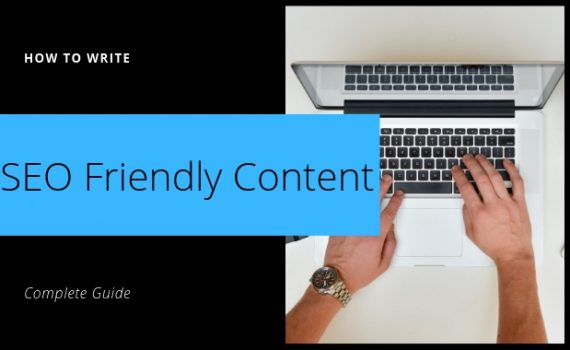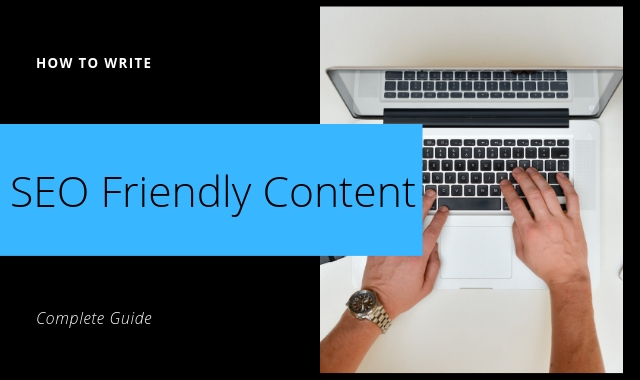
How to Write SEO Friendly Content
Category : On-page SEO
Most of the people think that SEO-optimized content cannot be great for users. It might be when people failed to create content that appeals to search engines but is not easily readable for uses. Writing both engaging and SEO friendly content requires a bit more efforts and there is a bunch of basics that need to be covered.
This guide will be able to walk you through the basics so that you’re able to start writing SEO-friendly content in no time!
Do Your Research
Before you even start the writing process, you need to know what keyword you’re targetting. You can’t just pick something general, like “cars,” and hope that its close association with what you do as a mechanic will cut through the noise on a search engine results page (SERP). To climb in the rankings, you have to find what keywords you can compete for.
Targetting local keywords is always a good bet, as it gets you a more targetted audience and you’ll have fewer people to compete against. “Car repair in Traverse City, MI” is fairly specific, for example.
You can also look at long-tail keywords, which are phrases that don’t receive very much traffic month-to-month but have next to no competition over. Targetting something like “1970 Ford Mustang Exhaust Repair” means that you’ll get the majority of the 100 people who search it a month, for example. Bundling many of these long-tail keywords together can build a steady stream of traffic to your site.
Keyword research is a complicated process, and there are many tools out there designed to tackle this beast. What is perhaps the most used tool is Google’s Keyword Planner, though you should also use Google’s Search Console to see what people are searching for before they enter your site. Dig through your existing traffic and do research into search trends to figure out what you should target in the future.
Keep Titles and URLs SEO-Friendly
The title of your article (which should always be formatted as an H1 header) should also stay within 70 characters. This means that the entire title will show up on search results pages, instead of being cut off with an ellipse at the end. This encourages people to click on your link, boosting your place in SERPs over time.
Further, you want to edit the actual URL so that it doesn’t show up as a mess of numbers and letters. You can usually use handy WordPress plugins to edit the final URL of pages and blog posts on your site (other tools exist for different web hosts as well).
Make sure that the URL matches the title as closely as possible, even making it the same if possible. You can use dashes (-) instead of spaces to make sure that the URL remains valid.
Add a Meta Description
The meta description is an HTML meta tag that you can add to any page. Its purpose is to provide a short description of your article for search engines and other crawlers.
Some SEO experts believe that the meta description tag on a page has become irrelevant. However, many others would disagree. At WPBeginner, we recommend using the meta description for all of your posts.
A good meta description can explain a lot more about an article. Social media websites like Facebook, Twitter, and LinkedIn also display it when your articles are shared on those platforms.
Since now you know that people are going to be reading your meta descriptions, you want to make sure that it’s helpful.
You also want to make sure that you at least mention your focus keyword once in the meta description for search purposes. The character limit for Meta Description is 155 characters.
Try to stay within that limit or your meta description will be truncated after 155 characters. You also want to make sure that you use the focus keyword earlier in the meta description rather than later.
Use Categories and Tags to Organize Content
Categories and tags help you sort your content not only for yourself, but for the readers and search engines.
The problem is that many WordPress beginners often end up using them incorrectly.
If you think about your website as a book, then categories would be the table of contents and tags will be the index part of the book.
Categories are used to divide your content into major topics discussed on your blog. Tags, on the other hand, are the topics discussed in an individual blog post.

Ways to write SEO Friendly Content
Optimize the Images Included in the Content
You can make your content exciting and more shareable by including high-quality pictures. Customers always prefer buying content from companies whose site includes impressive and attention-grabbing photos. So, adding relevant images is the best of the SEO-friendly content writing tips.
You can also optimize the images of your website by adding keywords in the image files and including ALT tags. It is important to maximize the size of the image as well. If the pictures are too big, then it will take minimum time to load. As a result, it may hurt your SEO rankings.
Therefore, create small images that are SEO-friendly but without compromising on the quality and visibility of the picture.
Write Content of Extremely Premium-Quality
Writing high-quality content should be self-evident; however, it is not always applied. The most excellent way to get more people to read and engage the material is to write entertaining and useful content. So, the next in the list of SEO-friendly content writing tips is to write high-quality content.
The reward is always offered to search engines with relevant and high-quality content. It is, therefore, essential to maintain the quality of your content.
Once you get to know how to write SEO-friendly content, you can use some additional tools to simplify and enhance the process and eventually make it SEO-friendly.
Create Shareable Content
Once you have been able to write SEO-friendly content successfully, then the next step is to make it shareable. The content must be vibrant and exciting so that more people wish to read it.
So, the next tip in the list of SEO-friendly content writing tips is to make sure that your content is shareable. You can take the help of websites like AddThis and ShareThis to include social media buttons to your website. This way, more people can share your content easily.
Optimize Your Article Length for SEO
Top-notch search engines, like Google, give priority to lengthier articles. But if your item is too long, then you will lose out readers. Your essay /article should be a minimum of 300 words in length.
So, the fourth in the list of SEO-friendly content writing tips is, though there is no specific limit to maximum word length, the only thing to ensure is to keep maintaining the interest of your readers. Hence, you can cap the range of your content around 700-800 words.
Additionally, you must maintain an appropriate keyword density for your content to make it SEO-friendly.
Read more Ways to make your content become the best
_______________________________________________________________________________
Please contact us for seo service packages at TDHSEO.COM.
TDHSEO Team
Email: tdhseo@gmail.com
Skype: tdhseo
https://www.facebook.com/tdhseo
Thank you!